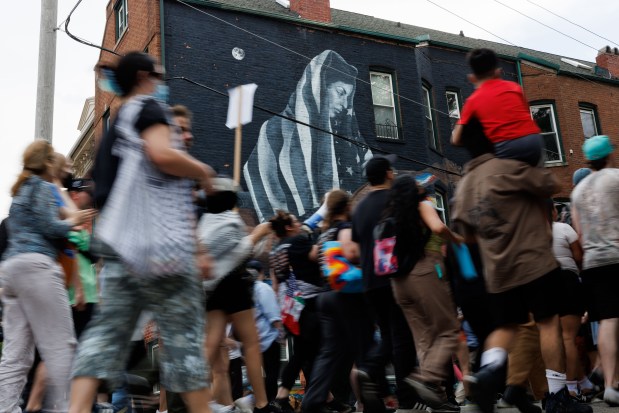Migrants living in city-run shelters have made up a relatively small number of Illinois Department of Child and Family Services investigations in Chicago.
At the peak of migrant shelter operations, thousands of people were crammed into dozens of shelters across the city. Despite the large influx of new arrivals, the number of DCFS investigations at over 35 sites that have at one time — or are currently — sheltering migrants was a small part of the agency’s total investigations in Cook County.
Since August 2022, more than 51,600 migrants have come through Chicago, the majority sent on buses by Gov. Greg Abbott of Texas, according to city census data. The mostly Venezuelan migrants have faced challenging conditions upon arrival, many without the ability to work legally and entering a housing market with a lack of available options.
Despite tough living conditions at shelters, migrant families appear to be mostly intact and able to care for themselves, according to DCFS data provided to the Tribune. Less than 1% of total DCFS investigations in Cook County were tied to a migrant shelter in each of the three consecutive years that asylum-seekers have been arriving in Chicago, according to the data.
In Cook County, there were 24 distinct investigations that involved someone at a migrant shelter out of almost 39,000 in 2022; 218 out of over 96,000 in 2023 and 276 out of more than 55,000 in 2024.
“Indeed, it is a very small portion of our investigations,” said Tierney Stutz, executive deputy director at DCFS.
Anyone with information on a potential case of child neglect or abuse may call DCFS’ hotline. Between 30% and 40% of hotline calls become investigations, in which DCFS officials travel to the site and assess the situation and the child’s safety.
After determining that a situation falls under the DCFS’ definition of abuse or neglect, the investigation is deemed “indicated” versus “unfounded.” In severe cases of abuse or neglect, DCFS will petition the court to have the child temporarily placed in DCFS custody.
According to the DCFS website, less than 10% of children who are part of an investigation enter foster care.
The statewide agency said it does not remove a child from their parents unless the child is at urgent, immediate risk of harm. Most often, DCFS works with other organizations to connect a family to outside services for help. The ultimate goal statewide is to return the child to a parent or guardian.
From Dec. 20, 2023, to last October, 16 children from Venezuela have entered into DCFS’ care, according to the most recent data.
DCFS is recruiting bilingual employees as well as foster parents to respond to these children’s immediate and future needs, officials said. People in Illinois can get help from DCFS until age 21, and officials said they place high importance on trauma-informed care for children who have made long migratory journeys.
Stutz said she typically gets a direct call from the city when there is a DCFS concern related to a migrant at a shelter. Chicago officials want to make sure they’re properly identifying the DCFS definition of abuse or neglect, she said.
“Sometimes the calls that come in for this setting are concerning for social issues, not abuse and neglect issues,” Stutz said.
About 90% of the DCFS investigations that occurred this year at migrant shelters were unfounded and 10% were indicated. This is a much higher margin than the average nationwide — typically 70% unfounded and 30% indicated, according to Stutz.
The 20% difference is likely caused by cultural misunderstanding, said Aimee Hilado, a professor, clinician and expert on immigrant trauma at the University of Chicago’s Crown Family School of Social Work. Shelters have put in place strict rules about leaving children alone without supervision, and there has been some mismatch in cultural boundaries, Hilado said.
“(The city) has been more thoughtful about educating staff on what is actual abuse and neglect, rather than just calling DCFS every time they’re concerned that a child is not being tended to by their parents,” she said.
DCFS said it does not have a contract to work with unaccompanied minors, or migrant children who come to the United States without guardianship. There are, however, overlaps between unaccompanied children and migrant children in DCFS care.
When there isn’t an adult access liaison between a migrant child and a service or an institution, that child can miss out on important processes such as filling out legal forms, said Salvadoran-American sociologist Stephanie Canizales, who wrote the book “Sin Padres, Ni Papeles: Unaccompanied Migrant Youth Coming of Age in the United States.”
“Migrant children who are undocumented face all sorts of barriers to accessing services,” Canizales said.
nsalzman@chicagotribune.com




